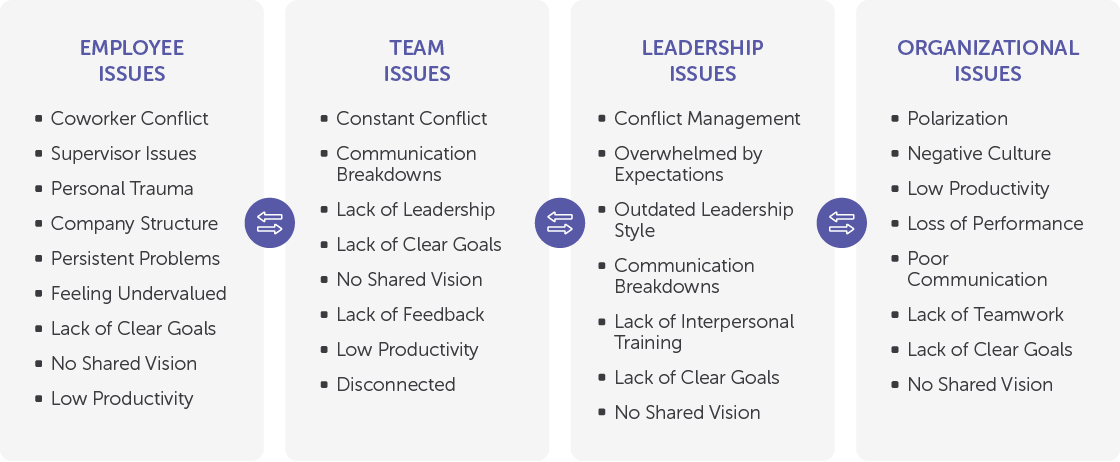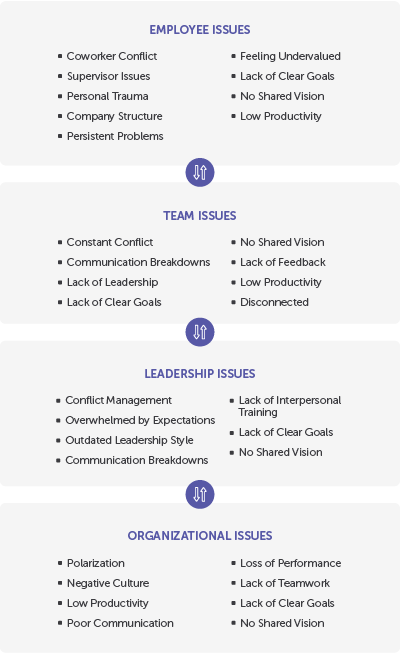Some people are said to be born leaders. Some people gravitate naturally to leadership positions in a quest for control or power. Some people rise up through the ranks. The most effective leaders are those who approach the position from the perspective of doing what’s in the best interest of all involved.
At every level of leadership—from the C-suite to middle management to team leads—dealing with conflict is an important skill to develop. Most of the problems that leaders and supervisors face involve operations, strategies, or people. These areas overlap and affect each other, often compounding issues and creating a complex situation that disrupts the organization on the whole.
This is inherently difficult territory to navigate. Unfortunately, many leaders assume the burden of blame, thinking they should naturally know how to handle such situations.
In reality, it is simply not true that accepting a position of leadership automatically endows the skills necessary to manage complex people situations. Today’s organizations call for a new kind of leader, one who is willing to reach out and be proactive about seeking help. There are resources available to train leaders to address disruptions in a way that not only solves the initial problem(s) but also takes the organization to new heights.
Modern organizations tend to be larger and populated by a more educated workforce that may have higher expectations than in the past. As a result, the structures of day-to-day operations and interpersonal intricacies have become more complex. The top-down management style that may have worked for previous generations is no longer effective. That’s why many forward-looking organizations are recognizing the need for a new approach to management.
Disruption can take root at any level of the organization. Some problems begin as employee issues that escalate to become team conflicts that eventually affect the entire organization. Issues can also begin at the management level and trickle down. Regardless, a problem at any level can undermine the organization's ability to work together effectively as a whole.



Business can run like a well-oiled machine—until a small problem that hasn’t been addressed causes the rest of the machine to slow down. Below are four areas that can impede the progress of solving issues.
Boosting the levels of employee satisfaction, engagement, and commitment should be a priority for every organization and its leadership. These are the base-level building blocks of an organization's operation. You may already be successful in some areas, while others need work. The health of the organization depends on your ability to positively influence the way employees think and feel about their work by helping them:
Change needs to happen at the core, with every interaction and every intention. Covering up symptoms will not fix the root problem that may grow to impact the entire organization. Just as you’d go to the doctor when you’re sick, turning to an expert for help is the best way to restore the health of your organization.
Organizations are constantly evolving, which means changing personnel, roles, and processes. It can be difficult for leaders to take a step back and see the big picture, especially when addressing a complex or long-existing problem. In the beginning, some are able to find the quick wins, but when daily operations proceed, they lose momentum. Putting a lasting solution in place takes time.
Consulting a third party can provide a fresh perspective and help you design a focused course of action that will not only address current issues but provide a sustainable solution for the future. Experts in leadership development and organizational coaching have the resources and experience necessary to help you bring about transformation. They take the burden off leaders and internal teams that may already be spread thin by work demands.
While large organizations frequently bring in outside experts to help solve certain problems, few consider seeking out a third party to help with employee, team, or company-wide interpersonal issues.
It may be tempting to take a DIY approach: ignoring the conflict, assuming people will work things out on their own, or trying to fix things but making them worse. Many times, upper management passes the buck to middle management, expecting them to fix “people problems” without equipping them to do so. Communication and processes are just as subject to breakdown as machinery, and hiring a consultant can offer the straightforward outcome organizations need to fix these crucial, foundational issues.
Most organizations wouldn’t want to design completely brand new workflows and processes any more than they can afford to start from scratch with entirely new technology systems. It often makes more sense to upgrade, update, or fix what is already in place. This is when a consultant can be invaluable to advise and address the situation from a high-level, beginning with strategy verification, revision, and development.
The first step to fixing a problem is recognizing that it exists; realizing that change is needed—now. The second step is knowing when and where to find help.
Think about your ideal workplace. What would it look like for your organization to be firing on all cylinders, aligned by a unified vision and clear goals that are supported by efficient processes and effective communication? Take inventory of where you are versus where you’d like to be.
If you believe your organization isn’t currently operating at peak productivity and performance, perhaps it’s time to take the next step and partner with an expert to help get you where you want to go.
It’s important to exercise due diligence and investigate the competency of a consultant to make sure they are the right fit for you. Ask if they will help you move in a unified direction that’s right for your organization, design productive teams and processes, and implement a sustainable plan geared for continuous improvement.

Identify issues, agree upon goals/responsibilities, create a shared vision

Forecast potential roadblocks, create a detailed plan to achieve desired transformation

Execute plan with continued focus on communication, training and collaboration

Assess commitment to the transformation process and vision, course-correct as necessary
There’s a general sense among many today that the morale culture and people’s ability to deal with others face-to-face is declining. It’s believed that this is negatively affecting organizations when people bring disruptive issues into the workplace.
The world we live in is calling for a new kind of leader.
It's a very complex undertaking, but there are resources available to help those who see the importance of creating a solid foundation for their organization. Sadly, many never reach out for help. But the best leaders do—and since you are reading this article, that includes you!
Remember, this isn't just about fixing the problem of the moment; it’s about making your organization more capable to handle the unseen challenges of tomorrow.
Anyone can lead. The real question is whether you want to be the kind of leader that people respect and therefore willingly follow—one that makes lasting improvements and imprints a legacy of success.
Managing people is by far the most challenging, but potentially the most rewarding, aspect of leadership. It’s extraordinarily hard to do well, especially if it’s not approached with intentionality and a good dose of humility.
At every level of the organization, each employee is a leader in some capacity and has wisdom to share. It should be reassuring to know that you can rely on the expertise available at each level—you don't have to know everything yourself. Plus, reaching out for ideas and insights makes your employees feel valued. Empowering people at every level will not only simplify your processes and workflow, but also foster commitment to the organization.
The right solution for your organization is unique. You can’t go find a recipe for success that fits every dynamic. Instead, it’s best to design a plan specifically to meet your organization’s challenges, goals, and needs.
Just as someone might consult a personal trainer to help get in physical shape, one of the most important things you can do as a manager is to seek out and choose the right experts and resources to help get your organization in shape.
The single most important step in becoming a new kind of leader is asking yourself what kind of leader you want to be. Do you want to settle for status quo and stick with tradition, even when it’s clearly not working? Or do you want to be part of something amazing that transforms your organization for years to come?
We thought so. That’s what we want too.
We’ll be your “thought partner” if you want to bounce questions off us. And we’ll suggest ways to find the right resources for your organization. Contact Us.
PO Box 23592
Overland Park, KS
66283 913-829-1241 866-691-0770